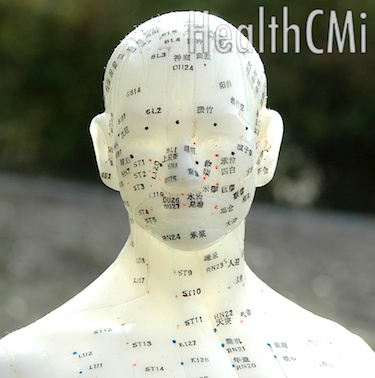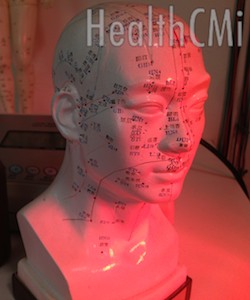Acupuncture improves the time it takes to regain consciousness from a coma after a severe brain injury. In a new randomized controlled study, researchers discovered an acupuncture point that delivers superior positive patient clinical outcomes. Acupuncture point GV25 (Suliao) outperformed acupuncture point GV26 (Shuigou), a classically indicated acupuncture point for revival of consciousness. 
GV25 treatments successfully revived patients within an average of 64.6 days after a severe craniocerebral injury. GV26 treatments were successful but took longer to revive patients, an average of 73.8 days. The total effective rate, a combination of cured and markedly effective, was 45.2% for the GV25 treatment group. The total effective rate for the GV26 group was 22.5%. The GV25 group was also more successful in evoking the sneezing reflex with an 85.7% success rate compared with 25% in the GV26 group. The research team notes, “The effect of acupuncture at Suliao (GV 25) on improving regain of consciousness from coma in severe craniocerebral injury is positive. It could specifically improve sneezing reflex and stimulate (the) respiratory center, which has (a) more obvious effect than acupuncture at Shuigou (GV 26).”
Acupuncture Points
The GV25 and GV26 groups both received the same approach to acupuncture point selection at secondary points including: Neiguan (PC6), Sanyinjiao (SP6), Yifeng (SJ17) and Wangu (GB12), Laogong (PC8), Yongquan (KD1). Effective rates for treatment were measured at 45 days and 90 days using the Glasgow coma scale combined with clinical efficacy scores. The study provides evidence that GV25 is more effective for revival than GV26, an unexpected result to many licensed acupuncturists. Both acupuncture points are indicated for revival of consciousness, however, GV26 is more commonly used in clinical practice. Let’s take a closer look at the Traditional Chinese Medicine (TCM) theory guiding classical usage of these acupuncture points.
GV26 (DU26) is above the midpoint of the philtrum, near the nostrils. GV26 is indicated within Traditional Chinese Medicine (TCM) for the treatment of mental disorders, hysteria, seizures and epilepsy, coma, apoplexy, trismus, deviation of the eyes and mouth, facial edema and lower back pain. GV26 is noted for the TCM functions of clearing the senses, cooing the heat, calming the spirit and benefiting the lumbar spine. GV26 is also classified as a ghost point. It is one of the 13 points of Sun Si-miao that are ascribed the function of being a ghost point, which are all indicated for the treatment of mania and epilepsy. The other ghost points are: LU11, SP1, P7, UB62, DU16, ST6, CV24, PC8, DU23, CV1, LI11, Yintang.
GV25 (DU25) is located on the tip of the nose. GV25 is indicated for loss of consciousness and shock, nasal obstruction, epistaxis, rhinorrhea and rosacea. GV25 is noted for the TCM functions of raising the yang, restoring the qi, clearing the senses and draining the heat.
Acupuncture Channel Theory
Traditional Chinese Medicine documents specific qualities, acupuncture points and pathways of the Governing Vessel (GV). Both GV points in the study are on the Governing Vessel (GV, DU). Pathological symptoms associated with qi obstruction in the GV include stiffness and pain along the spinal column. This acupuncture channel connects with and nourishes the brain and spinal region and intersects the liver channel at the vertex. Qi deficiency in the GV often causes a heavy sensation in the head, vertigo and shaking. Wind attack of the channel affects the brain and may lead to mental disorders. Febrile diseases are commonly associated with the Governing Vessel. 
One branch of the GV ascends through the abdomen. Pathology in the channel may lead to qi rushing upwards towards the heart. Indications for this imbalance include: colic, constipation, enuresis, hemorrhoids and functional infertility.
Coalescent points of the GV are UB12 and CV1. Disorders of the neck, shoulder, back and inner canthus are treated with the GV confluent point SI3 that connects with a paired confluent point of the Yangqiao channel, UB62. GV1 is the connecting point of the GV and supervises all the activities of the yang connecting channels on the head and back.
The luo (connecting) channel separates from the GV at GV1, which is located in the perineum. This channel travels upward along the spine bilaterally to the nape of the neck and then spreads over the top of the head. When the GV channel reaches the shoulder blades, it joins with the the UB and threads through the spine. Excess in the luo channel may cause stiffness along the spine and deficiency may lead to a feeling of heaviness in the head or dizziness.
Reference:
Xu, K. S., J. H. Song, T. H. Huang, Z. H. Huang, L. C. Yu, W. P. Zheng, X. S. Chen, and C. Liu. "Clinical efficacy observation of acupuncture at suliao (GV 25) on improving regain of consciousness from coma in severe craniocerebral injury." Zhongguo zhen jiu= Chinese acupuncture & moxibustion 34, no. 6 (2014): 529.


